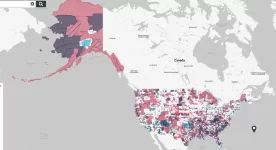If you're a small business operating in a Historically Underutilized Business Zone (HUBZone), you may be eligible for a powerful certification through the U.S. Small Business Administration (SBA). This certification can give your business a serious edge in winning federal contracts — including access to set-aside contracts and price evaluation preferences.
This guide walks you through how to apply, what documents you need, and where to start.

The HUBZone program is designed to fuel economic development in underserved communities by giving certified businesses preferential access to federal procurement opportunities.
If you're HUBZone certified, you can:
To qualify, your business must:
Here’s what most applicants need to gather:
Use the official SBA HUBZone map to check if:
 https://maps.certify.sba.gov/hubzone/map
https://maps.certify.sba.gov/hubzone/map
Before applying, your business must have:
Scan or digitize all documents listed above, as you'll be uploading them into the SBA system.
This is where you’ll complete your HUBZone application and upload supporting documents:
 HUBZone Application Portal: https://certifications.sba.gov/
HUBZone Application Portal: https://certifications.sba.gov/
 Create an SBA Connect account if you don’t already have one
Create an SBA Connect account if you don’t already have one
 Link it with your SAM.gov registration and UEI
Link it with your SAM.gov registration and UEI
 Begin your HUBZone application and follow the checklist
Begin your HUBZone application and follow the checklist
After submitting your application, the SBA may request additional documents or clarifications via the portal or email. Be sure to respond quickly to avoid delays.
You can log into the certification portal to track your application anytime at:
 https://certifications.sba.gov/
https://certifications.sba.gov/
HUBZone certification must be recertified annually. You’ll also need to notify the SBA of any material changes in:
Getting certified as a HUBZone business can significantly increase your access to federal contracts — but the application is documentation-heavy. The good news is: once you’re prepared, the process is straightforward.
If you're a sole owner (like I am), documents like your Operating Agreement, job description, and meeting minutes are still expected — even if your state doesn’t require them. They show operational control and structure to the SBA.
If you need help writing your documents, assembling your package, or confirming eligibility — feel free to reply or message me. I’ve been through it and can share what worked for my HUBZone and SDVOSB certifications.
This guide walks you through how to apply, what documents you need, and where to start.

 What Is the HUBZone Program?
What Is the HUBZone Program?
The HUBZone program is designed to fuel economic development in underserved communities by giving certified businesses preferential access to federal procurement opportunities.
If you're HUBZone certified, you can:
- Compete for HUBZone set-aside contracts
- Receive a 10% price evaluation preference in full and open competitions
- Gain a competitive edge in subcontracting relationships
 Basic HUBZone Eligibility Requirements:
Basic HUBZone Eligibility Requirements:
To qualify, your business must:
- Be a small business per SBA size standards
- Be at least 51% owned and controlled by U.S. citizens
- Have your principal office located in a designated HUBZone
- Have at least 35% of employees residing in a HUBZone
 Documents You’ll Need to Apply:
Documents You’ll Need to Apply:
Here’s what most applicants need to gather:
Required Business Documents:
- Articles of Organization (LLC) or Articles of Incorporation (Corp)
- Operating Agreement or Bylaws
- Organizational Meeting Minutes (especially if multi-member or corporate structure)
- Certificate of Good Standing from your state
- Business license or proof of lawful operation
Location & Proof of Operations:
- Lease agreement, deed, or utility bill for your primary office
- Photos or other documentation showing you work there regularly
Employee Residency Proof:
- Employee list with addresses
- Payroll records (last 1–2 pay periods)
- Driver’s licenses, leases, or voter IDs showing HUBZone residency for at least 35% of employees
Additional Supporting Items:
- Owner’s job description
- Vendor or contractor summaries (if using external services)
- Organizational chart (optional but helpful)
🛠 Step-by-Step: How to Apply for HUBZone Certification
1.
Use the official SBA HUBZone map to check if:
- Your principal office is located in a HUBZone, and
- At least 35% of your employees live in HUBZones
2.
Before applying, your business must have:
- A SAM.gov account (free)
- A Unique Entity ID (UEI) from SAM.gov
 Visit: https://sam.gov
Visit: https://sam.gov
3.
Scan or digitize all documents listed above, as you'll be uploading them into the SBA system.
4.
This is where you’ll complete your HUBZone application and upload supporting documents:
5.
After submitting your application, the SBA may request additional documents or clarifications via the portal or email. Be sure to respond quickly to avoid delays.
6.
You can log into the certification portal to track your application anytime at:
 After You Apply
After You Apply
- Processing time: Typically 30–90 days
- If approved, your business will be listed in:
- The HUBZone Directory
- Dynamic Small Business Search (DSBS), which federal buyers use
 Don’t Forget: Recertification
Don’t Forget: Recertification
HUBZone certification must be recertified annually. You’ll also need to notify the SBA of any material changes in:
- Office location
- Ownership
- Employee base
- Business operations
 Final Thoughts:
Final Thoughts:
Getting certified as a HUBZone business can significantly increase your access to federal contracts — but the application is documentation-heavy. The good news is: once you’re prepared, the process is straightforward.
If you're a sole owner (like I am), documents like your Operating Agreement, job description, and meeting minutes are still expected — even if your state doesn’t require them. They show operational control and structure to the SBA.
If you need help writing your documents, assembling your package, or confirming eligibility — feel free to reply or message me. I’ve been through it and can share what worked for my HUBZone and SDVOSB certifications.
